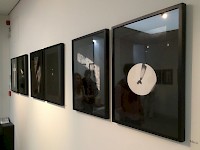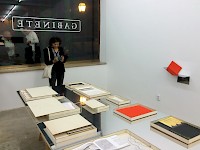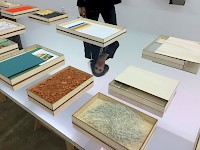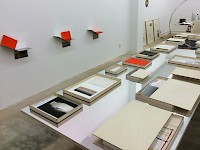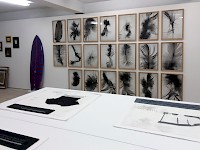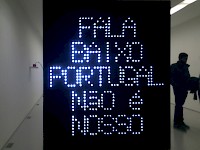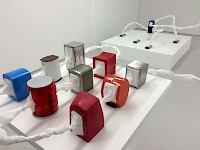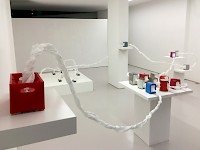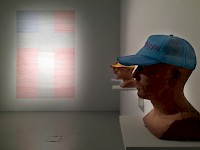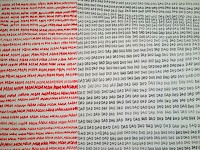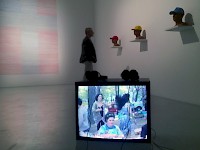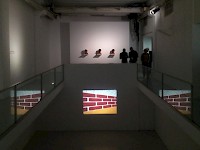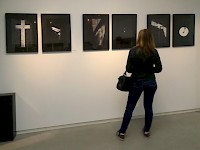BAIRRO DAS ARTES
A stroll in Bairro Alto, 17th September, 2015
Not long time ago, in the 1970's, before the Revolution, Bairro Alto was a truly medieval neighborhood with an agglomerated community never leaving its gloomy and labyrinthine streets, only a few alleys away from the wide river Tejo. It was a way of living inherited from the 16th-17th century, when Bairro Alto used to accommodate goods and people of various origins, clustering here from their commercial routs. 500 years ago, when Bairro Alto was erected, it was actually meant to embody modernity – implementing by royal decree fresh urban principles: eliminating for example the prevalent Islamic architectural setting dominated by wooden Mashrabiyas (a few wonderful balconies are nevertheless still preserved all over Lisbon). The new neighborhood was destined not for the most poor segment of the population, but for the exercise of various skills: cartography, engraving, painting - which set a century old tradition. It fortunately survived the great earthquake and fire of 1755 and, not being affected by massive restorations, it preserved its ambient of artistic seclusion, functioning quite autonomous. The Lisbon alternative-artistic community still keeps a fascination for the Bairro Alto of one generation before when its obsolete medieval housing and archaic living practices, started to be dominated by obscure clubs, a vagabond, creative energy and an emerging subculture. In 1982 the legendary CLUB FRAGIL opened in Bairro Alto, where artists, actors, musicians from the neighboring Conservatory and fashion designers met in an eccentric and permissive atmosphere, that fueled creative ventures.
The 6th edition of Bairro Alto's Bairro das Artes (17th September - 15th November 2015) taking place once a year and organized by the director of the Galeria Salgadeiras Ana Matos and one of its represented artists Claudio Garrudo, is meant to associate contemporary art galleries with cinemas, bookshops and performative events in one night of openings, parties and idea-launching across Bairro Alto. This year it brought together more than 50 international and local artists and 30 spaces. Looking back to its past editions, it functions like an archive of spaces that appeared and disappeared, as it is frequently the case in Lisbon, since 2010. It records initiatives that remained almost unknown despite great creative capital due to insufficient funding, precarious working spaces and the lack of supporting private or official cultural structures. In this sense, the creative movements in Bairro Alto are symptomatic for the local cultural scene, that constantly fights with shortages and instability and the impossibility to maintain professional initiatives.
Even the official statement of Bairro das Artes laments the sudden disappearance of iconic places like the Hall of the Deer, which was for many years the launching platform for young contemporary artists, an empty hall squeezed inside the dusty National Museum of Natural History and directed by the supportive curator Sofia Marçal.
Strolling with the photographer Fernando Veiras, the night of the Bairro Alto openings starts at the influential Galeria Graça Brandão (www.galeriagracabrandao.com), inaugurated in Lisbon in 2006, whose director José Mário Brandão led since 1986 a row of galleries in Porto and Lisbon. His contribution has been crucial in establishing solid collaborations between the Portuguese and Brazilian contemporary art scene, while he represents significant Brazilian avant-garde artists such as Lygia Pape and Nelson Leiner. The current show features Tiago Alexandre, Entre o Boné e os Ténis (‘Between The Cap And The Sneakers’ ), a young conceptual artists working around issues of social and personal identity construction. Essentially pop, his anthropomorphic symbols bring the viewer into an indistinct universe in which the same figures stand for consumerist, infantile, religious and official representation. His objects and writings embody maybe a hastily formed and swiftly changing personal, urban imaginary.
Two streets away is Galeria Salgadeiras (www.salgadeiras.com) the organiser of the Bairro das Artes events and featuring the exhibiton 'O Amor Mata' (Love Kills), by João Francisco Vilhena. The show devoted to the rather sordid but socially present theme of domestic violence is supported by the Portuguese Associaton of Victim Support. The exhibition is a long run project of the artist and fuses an overview of media information on the theme, anthropologic investigation (recorded interviews with specialists), material objects and his artistic interpretation. This exhibition inscribes itself in a line of interdisciplinary work, that has been constantly developed in the past years in Lisbon's artistic and academic environment. CRIA (The Network Center for Antropological Investigation, www.cria.org.pt) based at four Portuguese Universities, has had a tremendous role in joining artistic and performative with scientific work. Anthropologists like Teresa Fradique and Paulo Raposo based at CRIA have constantly built structures in which performative arts were not only practiced, but also socially embedded, offering precise functions in disadvantaged communities and areas. Their scientific work not only opened possibilities in the field of performative arts, but also elaborated new academic methodologies.
Bairro das Artes hosts also another cross disciplinary project, the recently opened Gabinete (https://www.facebook.com/gabinetelisboa). The space, directed by the curator and critic Delfim Sardo, is dedicated to architectural practice, which it approaches by means of contemporary art, putting on display a certain curatorial vision. The current exhibition is 'Laboratorio de Materias' by Fernanda Fragateiro, an influential name on the Portuguese art scene, working on the tradition of conceptual minimalism, with inputs of feminism and spatial investigation. This discreet show reloads the format 'book' into an architectural dimension: the virtual substance 'that the tool' book carries is transgressed into a physical presence. The container and vehicle functions of a book are objectified, at the same time expressing its tactile and textural potential. The idea of fold, present in contemporary architectural thinking, surfaces in this project in a chromatic note.
Mute (www.muteart.org), the next stop on our rout is a new artists run space, which is meant to create relations and networks between national and international artists. The project initiated by Manuel Furtado dos Santos and Miguelangelo Veiga is setting an accent on workshops and ateliers and intends to create exhibitions which are the outcome of a residency and research period. The present show of the Japanese artist living in Porto, Yuga Hatta reframes his personal perspective on the Portuguese economic crisis and its repercussions on the social sphere. The neon statement in the gallery window quotes: “Talk in a low voice, Portugal is not ours”, and refers Portuguese emigration in other European countries and the confused identity models that it has as a consequence, the prevalent fear of assuming personal responsibility and action regarding the national political situation. His paper thread installation is a visual symbol for another related problem: the strong social networks that on one hand strengthen the Portuguese society and on the other hand impend a free development of personal identity, whereas everyone conditions and partially limits the other.
A spectacular art venue at the extremity of Bairro Alto is the the 17th century Palácio Pombal, erected by Sebastião de Carvalho e Melo, the grandfather of the future diplomat and state secretary Marquês de Pombal. After the dramatic earthquake of 1755, Pombal rebuild from scratch the old town. The urbanistic vision which he implemented with a group of architects, created a salubrious and transparent city, with wide avenues and houses containing a sophisticated wooden structure meant to resist future earthquakes and inhabited until today. The beautiful residency of the Pombal family with its vast garden hosts now Carpe Diem Arte e Pesquisa, with exhibition spaces, ateliers and garden cafes. The present group show contains works of Bruno Vilela (BR), Daniela Krtsch (D), David Oliveira (PT), Luísa Jacinto (PT), Paula Scamparini (BR), Pedro Palma, Pedro Pires & João Dias (PT) produced during their residency in the space, all meant to reflect back on the historic dimension of the site. I would like to especially mention the work of João Dias+Pedro Pires, which construct unlogical structures, climb them and reinvent the position of the human in relation to our built environment. Vision and flying machines meant to fail, bricollage and assemblage that extend the functions of the body recall experiments such of the famous 1920 Bauhaus Buehne (Bauhaus Stage) and the Triadic Ballets of Oskar Schlemmer. Rich references from Renaissance and avantgardist experiments with adventurous mechanics are combined also with a contemporary taste for prostehtic extensions.
This small overview of a night's new arts in old Bairro Alto ends with Mercurio, the exhibition of Antonio Julio Duarte in Galeria Ze dos Bois, another cult space for the Portuguese experimental art scene. The collection of large format photographs curated by the founder of ZDB Natxo Checa is immersed in the dark and labyrinthine corridors of another massive pombaline architecture. The immaculately solved exhibition setting devoid of any artifice, immerses the viewer in hallucinating, over-exposed visual surfaces, beyond which dwells a broken, and at the same time enchanting, ungraspable and poisonous reality. The show has of course a universal relevance, but is for sure symptomatic for the autochthonous cultural field, with Mercury representing the accident between the viewer (or the self) and an often not-assimilable quotidian, social experience.
Marta Jecu
